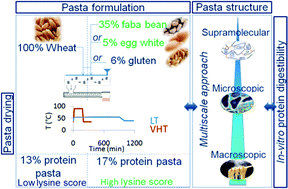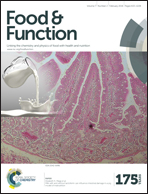Protein enriched pasta: structure and digestibility of its protein network
Abstract
Wheat (W) pasta was enriched in 6% gluten (G), 35% faba (F) or 5% egg (E) to increase its protein content (13% to 17%). The impact of the enrichment on the multiscale structure of the pasta and on in vitro protein digestibility was studied. Increasing the protein content (W- vs. G-pasta) strengthened pasta structure at molecular and macroscopic scales but reduced its protein digestibility by 3% by forming a higher covalently linked protein network. Greater changes in the macroscopic and molecular structure of the pasta were obtained by varying the nature of protein used for enrichment. Proteins in G- and E-pasta were highly covalently linked (28–32%) resulting in a strong pasta structure. Conversely, F-protein (98% SDS-soluble) altered the pasta structure by diluting gluten and formed a weak protein network (18% covalent link). As a result, protein digestibility in F-pasta was significantly higher (46%) than in E- (44%) and G-pasta (39%). The effect of low (55 °C, LT) vs. very high temperature (90 °C, VHT) drying on the protein network structure and digestibility was shown to cause greater molecular changes than pasta formulation. Whatever the pasta, a general strengthening of its structure, a 33% to 47% increase in covalently linked proteins and a higher β-sheet structure were observed. However, these structural differences were evened out after the pasta was cooked, resulting in identical protein digestibility in LT and VHT pasta. Even after VHT drying, F-pasta had the best amino acid profile with the highest protein digestibility, proof of its nutritional interest.


 Please wait while we load your content...
Please wait while we load your content...